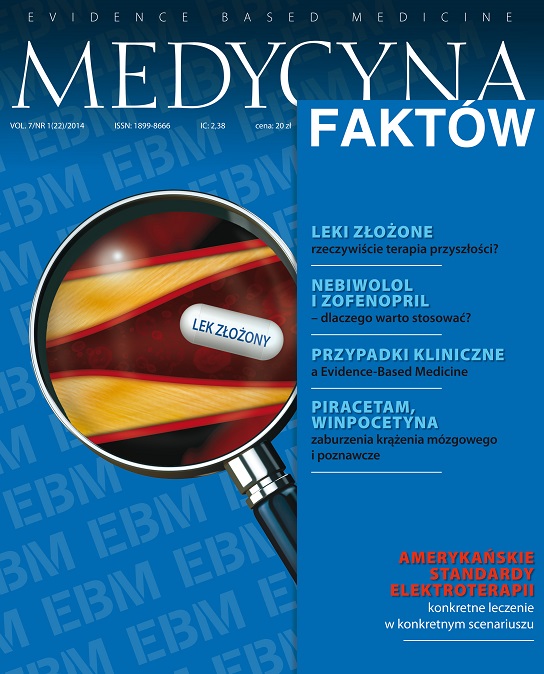Leki złożone w leczeniu nadciśnienia tętniczego – droga do poprawy skuteczności terapii i rokowania Artykuł przeglądowy
##plugins.themes.bootstrap3.article.main##
Abstrakt
Nadciśnienie tętnicze (NT) jest najważniejszym problemem zdrowotnym świata i ważnym modyfikowalnym czynnikiem ryzyka incydentów sercowo-naczyniowych. Osiągnięcie optymalnej docelowej wysokości ciśnienia tętniczego często wymaga stosowania więcej niż jednego leku. Terapia złożona zapewnia wiele korzyści, takich jak większa skuteczność i przestrzeganie zaleceń. Stałe połączenie leków w jednej tabletce zapewnia prostą i dobrze tolerowaną terapię. Na podstawie wyników wielkich prób klinicznych analizujących incydenty sercowo-naczyniowe preferowane są połączenia zawierające inhibitor konwertazy (lub sartan) i bloker kanału wapniowego albo inhibitor konwertazy (lub sartan) z diuretykiem. Niektóre kombinacje leków nie są rekomendowane, a nawet mogą być szkodliwe, np. podwójne blokowanie układu renina–angiotensyna. Terapię złożoną od początku leczenia zaleca się szczególnie u pacjentów z ciśnieniem skurczowym o 20 mmHg i rozkurczowym o 10 mmHg przekraczających docelowe oraz u chorych z wysokim ryzykiem sercowo-naczyniowym. W najnowszych wytycznych podkreśla się i preferuje stosowanie trwałych połączeń leków w jednej tabletce.
##plugins.themes.bootstrap3.article.details##
Copyright © by Medical Education. All rights reserved.
Bibliografia
2. The Seventh Report of the Joint National Committee on Prevention, Detection, Evaluation and Treatment of High Blood Pressure. The JNC 7 Report. JAMA 2003; 289: 2560-2575.
3. Go A., Bauman M., Sallyann M. et al.: An Effective Approach to High Blood Pressure Control. A Science Advisory From the American Heart Association, the American College of Cardiology, and the Centers for Disease Control and Prevention. JACC 2013 [online: 10.1016/j.jacc.2013.11.007].
4. Weber M., Schiffrin E., White W. et al.: Clinical Practice Guidelines for the Management of Hypertension in the Community. A Statement by the American Society of Hypertension and the International Society of Hypertension. The Journal of Clinical Hypertension 2013 [online: DOI: 10.1111/jch.12237].
5. Mancia G., Robert Fagard R., Narkiewicz K. et al.: ESH/ESC Guidelines for the management of arterial hypertension. European Heart Journal 2013; 34: 2159-2219.
6. Widecka K., Grodzicki T., Narkiewicz K. et al.: Zasady postępowania w nadciśnieniu tętniczym – 2011 rok. Wytyczne Polskiego Towarzystwa Nadciśnienia Tętniczego. Nadciśnienie Tętnicze 2011; 15: 55-85.
7. Tykarski A., Widecka K., Filipiak K.: Zalecenia ESH/ESC 2013 dotyczące postępowania w nadciśnieniu tętniczym. Próba komentarza na temat zmian i różnic w porównaniu z zaleceniami PTNT 2011. Nadciśnienie Tętnicze 2013; 17: 269-313.
8. [online: www.natpol.org/].
9. Dahlöf B., Sever P.S., Poulter N.R. et al.; Ascot Investigators: Prevention of cardiovascular events with an antihypertensive regimen of amlodipine adding perindopril as required versus atenolol adding bendroflumethiazide as required in the Anglo-Scandinavian Cardiac Outcomes Trial-Blood Pressure Lowering Arm (ASCOT-BLA): a multicentre randomised controlled trial. Lancet 2005; 366: 895-906.
10. Williams B., Lacy P.S., Thom S.M. et al.: Differential impact of blood pressure-lowering drugs on central aortic pressure and clinical outcomes: principal results of the Conduit Artery Function Evaluation (CAFE) Study. Circulation 2006; 113: 1213-1225.
11. Rothwell P.M., Howard S.C., Dolan E.: Effects of β-blockers and calcium-channel blockers on within-individual variability in blood pressure and risk of stroke. The Lancet Neurology 2010; 9: 469-480. 12. 2007 Guidelines for the management of arterial hypertension. The Task Force For the Management of Arterial Hypertension of the European Society of Hypertension (ESH) and of the European Society of Cardiology (ESC). J. Hypertens. 2007; 25: 1105-1187.
13. [online. www.nice.org.uk].
14. Bangalore S., Kamalakkannan G., Parkar S. et al.: Fixed-dose combination improves medication compliance: a meta-analysis. Am. J. Med. 2007; 120: 713-719.
15. Parving H.H., Brenner B.M., McMurray J.J. et al.; ALTITUDE Investigators: Cardiorenal end points in a trial of aliskiren for type 2 diabetes. N. Engl. J. Med. 2012; 367(23): 2204-2213.
16. Yusuf S., Teo K.K., Pogue J. et al.; ONTARGET Investigators: Telmisartan, ramipril, or both in patients at high risk for vascular events. N. Engl. J. Med. 2008; 358(15): 1547-1559.
17. van Vark L.C., Bertrand M., Akkerhuis K.M. et al.: Angiotensin converting enzyme inhibitors reduce mortality in hypertension: a meta-analysis of randomized clinical trials of renin-angiotensin-aldosteron system inhibitors involving 158 998 patients. Eur. Heart J. 2012; 33: 2088-2097.
18. Savarese G., Costanzo P., Cleland J.G. et al.: A Meta-Analysis Reporting Effects of angiotensin-Converting Enzyme Inhibitors and Angiotensin Receptor Blockers in Patients Without Heart Failure. J. Am. Coll. Cardiol. 2013; 61: 131-42.
19. Gradman A., Parisé H., Lefebvre P. et al.: Initial combination therapy reduces the risk of cardiovascular events in hypertensive patients: a matched cohort study. Hypertens. 2013; 61: 309-318.
20. Jamerson K., Weber M., Bakris. G. et al.: Benazepril plus Amlodipine or Hydrochlorothiazide for Hypertension in High-Risk Patients. N. Engl. J. Med. 2008; 359: 2417-242.
21. Beckett N.S., Peters R., Fletcher A.E. et al.; HYVET Study Group: Treatment of hypertension in patients 80 years of age or older. N. Engl. J. Med. 2008; 358(18): 1887-1898.
22. Patel A., MacMahon S., Chalmers J. et al.; ADVANCE Collaborative Group: Effects of a fixed combination of perindopril and indapamide on macrovascular and microvascular outcomes in patients with type 2 diabetes mellitus (the ADVANCE trial): a randomised controlled trial. Lancet 2007; 370(9590): 829-840.
23. DiNicolantonio J., Lavie C., O’Keefe J. et al.: Angiotensin-Converting Enzyme Inhibitors Are Equal: Focus on Ramipril and Perindopril. Postgraduate Medicine 2013; 4(125): 154-168.
